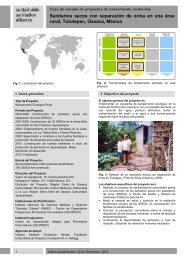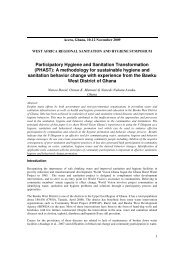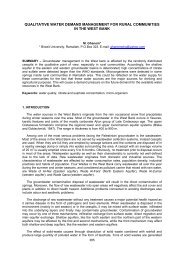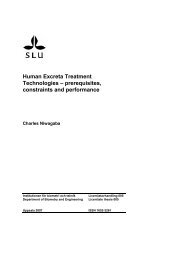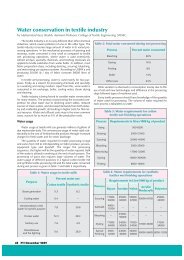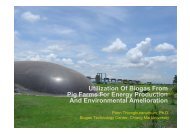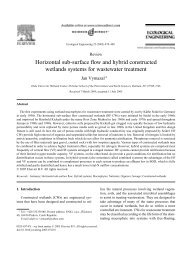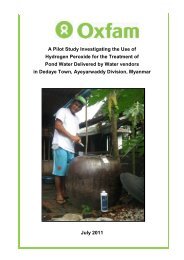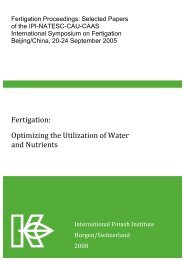The Incinerator Guidebook: A Practical Guide for Selecting ... - SSWM
The Incinerator Guidebook: A Practical Guide for Selecting ... - SSWM
The Incinerator Guidebook: A Practical Guide for Selecting ... - SSWM
Create successful ePaper yourself
Turn your PDF publications into a flip-book with our unique Google optimized e-Paper software.
Auto-combustion incinerators<br />
In an auto-combustion system, the<br />
incinerator is preheated using dry wood<br />
and/or other agricultural residues (e.g.,<br />
coconut shells, charcoal, etc.). At some<br />
point, the waste itself generates the heat <strong>for</strong><br />
continued combustion during the waste<br />
disposal process. Auto-combustion<br />
incinerators are substantially cheaper to<br />
operate than fuel-assisted incinerators,<br />
however auto-combustion incinerators are<br />
not suited to destroy placenta or anatomic<br />
waste unless anatomic waste is interspersed<br />
with safety boxes, dry wood, or charcoal in a<br />
ratio of 1 kilogram of anatomic waste to 3<br />
kilograms or more of plastic, wood or<br />
charcoal.<br />
Figure 1. Standard components of a small-scale incinerator.<br />
Auto-combustion incinerators are able to<br />
destroy non-sharps infectious waste if the<br />
ratio by weight of safety boxes, wood, or<br />
charcoal to non-sharps waste is 2:1 or<br />
greater. In consideration of the amount of<br />
plastic waste generated by injections, it is<br />
important that incinerator technologies<br />
which can destroy 50 to 100 percent plastic<br />
in the waste load without causing damage to the refractory materials are selected. It is important<br />
that metalwork in the incinerator is stainless steel or cast iron if incinerator equipment is expected<br />
to be operational <strong>for</strong> more than three years without replacement.<br />
Fuel-assisted incinerators<br />
Fuel-assisted incinerators require a fossil fuel (diesel or gas) and a continuous electrical power<br />
supply to operate. Fuel-assisted incinerators are sometimes prone to damage if an electrical power<br />
failure occurs during operation.<br />
<strong>The</strong> better-designed fuel-assisted incinerators control the fuel supply in order to maintain constant<br />
combustion temperatures and to economize on fuel consumption. Fuel is injected into both the<br />
primary and secondary chambers, along with auxiliary air through blowers.<br />
Most fuel-assisted incinerators with a capacity to destroy 100 to 150 kilograms of waste per day<br />
consume 5 to 8 liters per hour of fuel (4 to 6.5 kilograms of gas). It is important to note that some<br />
fuel-assisted incinerators cannot destroy more than 15 to 25 percent of plastic per load because of<br />
the high caloric value of plastics and the damage that can be caused to the refractory lining.<br />
Temperature<br />
An incinerator should operate in the temperature range of 800° to 1200°C when medical waste is<br />
incinerated. Toxic fumes including furans and dioxins are emitted at temperatures below 600°C if<br />
polyvinyl chloride or certain other materials are incinerated.<br />
5



